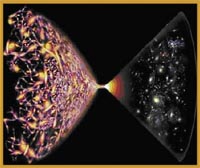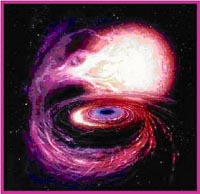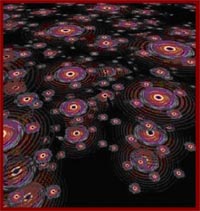 |
 |
Main Listing |
Universe Endgame
100 Million Years From Now
If the universe is now 14 billion years, this small step will be to 14.1 billion years or 1.41x1010 years. This is more than enough time for us to have populated the Galaxy (20 million will do), and we can be expected to have started "farming" the stars. This is millions of years beyond the era of most galactic-scale science fiction novels, which are presumed to take place a million or so years after population of the galaxy.Population II stars (the old ones in the core of our and other galaxies) are even older but there is no perceptible dimming - these stars are already billions of years old. Old elliptical galaxies will look the same. There are, however, new stars in galactic spiral arms and whole generations of large, hot stars have burnt out. The constellations seen from Earth will all have changed. There will be fewer of the hot plasma bubbles from supernovae than are currently present in interstellar space within spiral galaxies.
1014 Years; 100,000 Billion Years
This is 7000 times longer than the current age of the Universe, which becomes comparable to the first day of a 19 year-olds' lifetime. The Sun is long gone; it went Red Giant at about 20 billion years, frying the Earth, which had become uninhabitable due to the evaporation of the oceans and atmosphere. For that matter, all the stars are dying - dwarf stars can last longest at 100 billion years. The universe is left with neutron stars, Black holes, and a few white dwarfs. Some Black Holes have "evaporated" after being ejected from galaxies by chance graviatational interactions. There are supermassive Black Holes at the centers of most galaxies. Our galaxy core is enlarged and dragging matter in; the spiral arms are gone. Clusters of stars may have been artificially gathered around the galactic rim by living beings. These small cold stars have collections of tidally-locked planets, that is, the ones that have not been transformed into Dyson spheres. The cosmic background temperature, 2.7 oK in our era, is now a mere 0.01 oK, the fading whisper of the Big Bang.
1025 Years; Ten Million Billion Billion Years
Ninety percent of all stars have evaporated from galaxies. The remaining 10% are located in what is left of galaxy cores. There, supermassive Black Hole accretion disks sweep up the stars within their gravitational pull. Farther out, the accretion disks of smaller Black Holes emit x-rays and heat. Their energy emission is greater than all the stars in the present Universe. The Universe has expanded to 1016 times its current size. To the beings of this era, our 14 billion year old Universe is like the first 3 hours after Big Bang is to us.
1065 Years; too long to describe rationally
Proton decay lifetimes are estimated to be greater than 1064 years, so particulate matter will still exist. Galactic clusters remain only as giant Black Holes, 1014 solar masses, equal to 1000 galaxies. Will Life be exploiting their Hawking radiation, that feeble leakage of light predicted by theory? Small solar mass Black Holes have all evaporated. To any beings alive at this time, our era of the first 14 billion years would be as indistinguishable as the first small fractions of a second in the Big Bang are to us.
10100 Years
The last remaining structures are 1017solar mass galactic supercluster Black Holes orbiting each other. Any life will be feeding off the last trickle of Hawking energy and Black Hole merging energy.
10117 Years
Almost all ordinary matter has evaporated, remnant particles are light-years apart. The Universe is a cold and lonely place.
|
back to top |
| © 2001 All Rights Reserved, CalSpace Institute |




